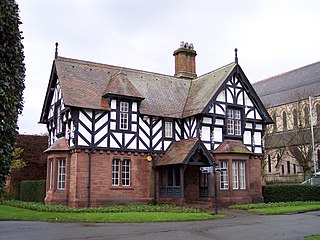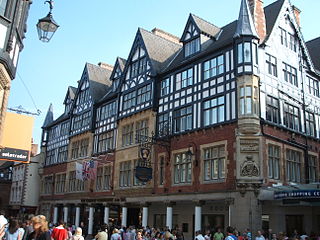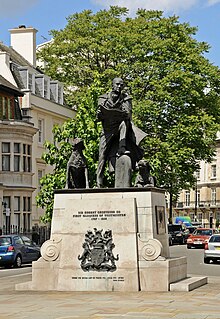
Duke of Westminster is a title in the Peerage of the United Kingdom. It was created by Queen Victoria in 1874 and bestowed upon Hugh Grosvenor, 3rd Marquess of Westminster. It is the most recent dukedom conferred on someone not related to the British royal family.

Hugh Lupus Grosvenor, 1st Duke of Westminster,, styled Viscount Belgrave between 1831 and 1845, Earl Grosvenor between 1845 and 1869, and known as The Marquess of Westminster between 1869 and 1874, was an English landowner, politician and racehorse owner. He inherited the estate of Eaton Hall in Cheshire and land in Mayfair and Belgravia, London, and spent much of his fortune in developing these properties. Although he was an MP from the age of 22, and then a member of the House of Lords, his main interests were not in politics, but rather in his estates, in horse racing, and in country pursuits. He developed the stud at Eaton Hall and achieved success in racing his horses, who won the Derby on four occasions.

Belgravia is a district in Central London, covering parts of the areas of the City of Westminster and the Royal Borough of Kensington and Chelsea.

Richard Grosvenor, 2nd Marquess of Westminster, styled The Honourable Richard Grosvenor from 1795 to 1802, Viscount Belgrave from 1802 to 1831 and Earl Grosvenor from 1831 to 1845, was an English politician, landowner, property developer and benefactor.

Berkeley Square is a garden square in the West End of London. It is one of the best known of the many squares in London, located in Mayfair in the City of Westminster. It was laid out in the mid 18th century by the architect William Kent, and originally extended further south. The garden's very large London Plane trees are among the oldest in central London, planted in 1789.

Eaton Hall is the country house of the Duke of Westminster. It is 1 mile (2 km) south of the village of Eccleston, in Cheshire, England. The house is surrounded by its own formal gardens, parkland, farmland and woodland. The estate covers about 10,872 acres (4,400 ha).

Grosvenor House was one of the largest townhouses in London, home of the Grosvenor family for more than a century. Their original London residence was on Millbank, but after the family had developed their Mayfair estates, they moved to Park Lane to build a house worthy of their wealth, status and influence in the 19th century. The house gave its name to Upper Grosvenor Street and Grosvenor Square.

Grosvenor Square is a large garden square in the Mayfair district of Westminster, Greater London. It is the centrepiece of the Mayfair property of the Duke of Westminster, and takes its name from the duke's surname "Grosvenor". It was developed for fashionable residences in the 18th century. In the 20th it had an American and Canadian diplomatic presence, and currently is mixed use, commercial.

Robert Grosvenor, 1st Marquess of Westminster, was the son of the 1st Earl Grosvenor, whom he succeeded in 1802 as 2nd Earl Grosvenor. He was created Marquess of Westminster in 1831. He was an English Member of Parliament (MP) and an ancestor of the modern-day Dukes of Westminster. Grosvenor continued to develop the family's London estates, he rebuilt their country house, Eaton Hall in Cheshire where he also restored the gardens, and built a new London home, Grosvenor House. He maintained and extended the family interests in the acquisition of works of art, and in horse racing and breeding racehorses.

Coade stone or Lithodipyra or Lithodipra is stoneware that was often described as an artificial stone in the late 18th and early 19th centuries. It was used for moulding neoclassical statues, architectural decorations and garden ornaments of the highest quality that remain virtually weatherproof today.

Grosvenor Park is a public park in the city of Chester, Cheshire, England. It consists of 20 acres (8.1 ha) of land overlooking the River Dee. It is regarded as one of the finest and most complete examples of Victorian parks in the North West of England, if not nationally. On 22 August 2013 the designation of the park was raised from Grade II in the National Register of Historic Parks and Gardens to Grade II*.

St George's Square is a prestigious and very long garden square in affluent Pimlico, Central London. It benefits from gardens and a church in its central area. Near the northern acute angle, the square is intersected by Lupus Street. Pimlico tube station is a short distance east. Its north-east side is in effect Belgrave Road and southern side is arterial Grosvenor Road which is lined by a small public garden in front of the River Thames.

The Chester Grosvenor Hotel is a hotel in Chester, Cheshire, England. The Grade II listed building was built between 1863 and 1865 and is owned by the Duke of Westminster.
Captain The Honourable Norman de l'Aigle Grosvenor, was a British Liberal Party politician.

The Statue of Richard Grosvenor, Second Marquess of Westminster is in Grosvenor Park, Chester, Cheshire. England. It was designed by Thomas Thornycroft and was erected to commemorate the generosity of the Marquess. The statue was unveiled in 1869, and was paid for by public subscription. It is recorded in the National Heritage List for England as a designated Grade II listed building.

Colonel Eustace James Anthony Balfour was a London-based Scottish architect. The brother of one British Prime Minister and nephew of another, his career was built on family connections. His mother was the daughter of a Marquess, and his wife Frances, a noted suffragist, was the daughter of a Duke. Frances's sister in-law was Princess Louise, daughter of the reigning Queen Victoria.

Peterborough House, on the south-west side of Parsons Green, near Eel Brook Common, was a London townhouse owned by the Mordaunt family, Earls of Peterborough and later by the Grosvenor family. It was the most westerly townhouse in the City of Westminster.

Grosvenor Gardens is the name given to two triangular parks in Belgravia, London, faced on their western and eastern sides by streets of the same name. Both roads run roughly north to south from Hobart Place and Grosvenor Place to Buckingham Palace Road, and is entirely the A3215.
This is a list of the etymology of street names in the London districts of Pimlico and Victoria. The area has no formally defined boundaries – those utilised here are the generally accepted ones of: Vauxhall Bridge Road to the north-east, the river Thames to the south, the Victoria railway line, Buckingham Palace Road/Buckingham Gate/Grosvenor Gardens to the west and Lower Grosvenor Place/Bressenden Place to the north. Victoria is a vaguely defined area, but is generally used to refer to streets immediately around the station of that name.

















